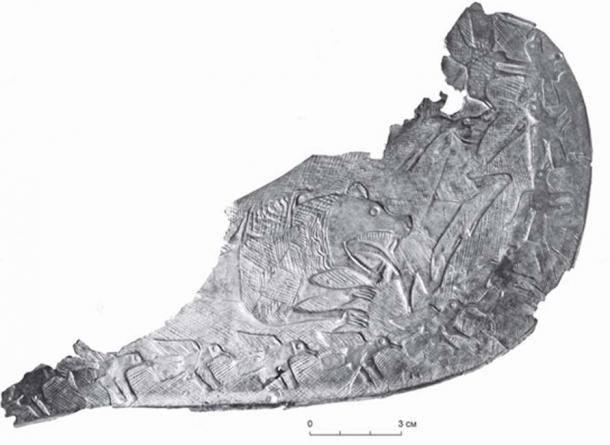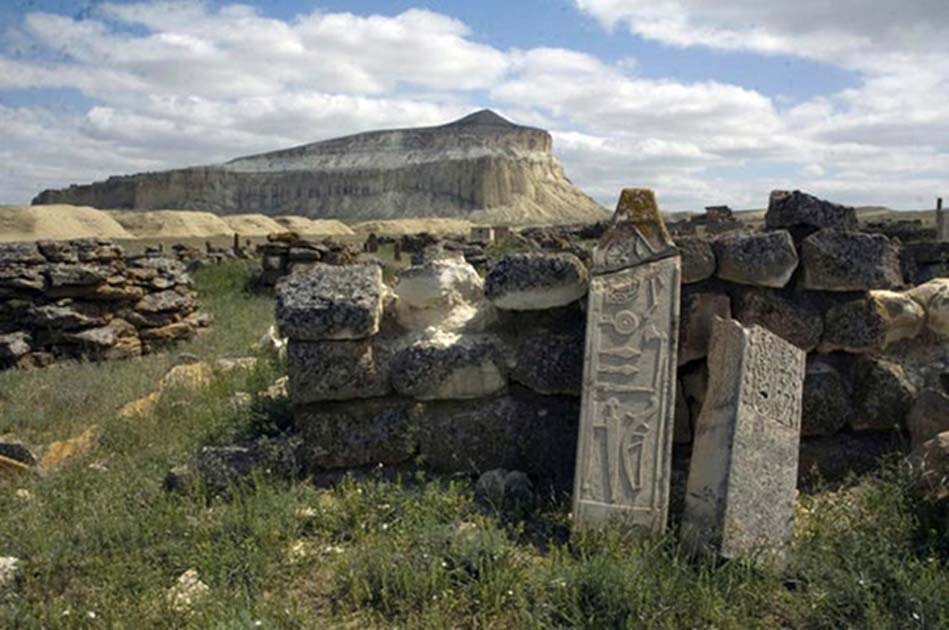Mysterious 1,500-Year-Old Stone Complex Unearthed in Kazakhstan
A mysterious stone complex which may have been built by the Huns has been discovered in Kazakhstan. It contains some stones which look exactly like ones found at Stonehenge in the UK. The site also contained some precious silver treasures.
According to LiveScience, the complex was identified during research conducted by Andrey Astafiev of the Mangistaus State Historical and Cultural Reserve, and Evgeniï Bogdanov of the Russian Academy of Sciences Siberian Department's Institute of Archaeology and Ethnography. The complex is huge, covering an area larger than 200 American football fields (about 120 hectares or 300 acres). The site is known as Altÿnkazgan and it is located in Kazakhstan near the eastern shore of the Caspian Sea.
The researchers identified several types and sizes of stone structures at the site. The smallest is 4 by 4 meters (13 ft x 13 ft), but the largest found to date measures 34 by 24 meters (112 ft by 79 ft). It is easy to note similarities between the site and structures found at Stonehenge. Astafiev and Bogdanov also found impressive carvings of creatures and weapons on some of the stones.

A stone structure and a carved stone that shows an animal. (Live Science)
The researchers recently published an article about their discovery in the journal Ancient Civilizations from Scythia to Siberia. Apart from the stones and carvings, they have made other spectacular finds at the site. For example, they discovered the remains of a saddle made with silver elements and decorated with images of deer, wild boars, and other beasts (perhaps lions).
This outstanding artifact sheds some light on the origins of the mysterious complex. Astafiev and Bogdanov wrote that the decoration is a relief which was impressed onto the front of the saddle surface. They believe that the ancient artisan(s) first designed the images on leather and then glued them onto wooden boards. Silver plates were then fixed over the shapes.
- Ancient instrument found in Turkic warrior burial in Kazakhstan
- Woman buried with weapons is first evidence of female warriors among the Kangyuy people of Kazakhstan
The site was discovered in 2010 by a man known as F. Akhmadulin who lives in the town of Aktau. He discovered the remarkable site using a metal detector. Akhmadulin was searching the area around the Mangÿshlak Peninsula when he found some artifacts such as the silver saddle. He informed Astafiev about the discovery, enabling the researchers to uncover even more magnificent treasures.

The saddle’s silver facing. (Andrey E. Astafiev & Evgeniï S. Bogdanov)
The archaeological site is in a sagebrush desert, so it was not especially difficult for the researchers to find. However, the region’s socioeconomic situation prevented them from starting work for four years. They started to dig in 2014 where Akhmadulin discovered the silver saddle and unearthed more of it. They also found other artifacts such as two bronze pieces which are probably the remains of a whip.
The researchers’ main questions are: who built the stone complex and who owned the precious artifacts. By analyzing the saddle, they found that the decoration can be dated back to the period of the Roman Empire’s collapse. At that time, the Huns were traveling across Asia and Europe - and the owner of the saddle was most probably one of them. As Astafiev and Bogdanov told LiveScience, the Huns “led various ethnic groups in the Eurasian steppes to move from their previous homelands.”

Silver facing from the rear end of a saddle flap found at the site. (Andrey E. Astafiev & Evgeniï S. Bogdanov) The image shows a beast attacking another creature while a bird attacks the animal’s nose. More birds are depicted around the edge of the saddle flap.
The researchers hope to continue their work at Altÿnkazgan. They informed LiveScience that an article about the silver saddle is planned for publication in 2017. As of now, they have only concluded that the owner of the saddle was a wealthy and powerful person. Symbols engraved on the saddle called “tamgas” suggest the privileged status of the owner in his society. Moreover, it could have also been a family symbol. Archaeologists also unearthed a human skeleton at the site, however the relationship between the saddle and bones is still unclear.
- NASA Sparks Interest in Enigmatic Earthworks of Kazakhstan
- Ancient Geoglyphs of Kazakhstan: The Mysterious Markings in Danger of Destruction

The arid location around the archaeological site. (Evgeniï Bogdanov)
Altÿnkazgan is another example of a remarkable archaeological discovery made in Kazakhstan over the last few years. April Holloway reported another exciting find in September, 2014 with the discovery of “the Nazca lines of Kazakhstan – more than 50 giant geoglyphs formed with earthen mounds and timber found stretched across the landscape in northern Kazakhstan. They are designed in a variety of geometric shapes, including crosses, squares, rings, and even a swastika, an ancient symbol that has been in use for at least 12,000 years.”
Holloway reported that “the geoglyphs, which are very difficult to see on the ground, were first spotted on Google Earth. Since then, a team of archaeologists from Kostanay University in Kazakhstan and Vilnius University in Lithuania, have investigated the giant structures using aerial photography and ground-penetrating radar. Their results revealed a wide variety of shapes ranging from 90 to 400 metres in diameter, mostly made of earthen mounds, but one – the swastika – was made using timber. Researchers have not yet dated the structures but their characteristics suggest they are around 2,000 years old.”

Some of the geoglyphs found in northern Kazakhstan. Credit: Image copyright DigitalGlobe, courtesy Google Earth
Top Image: A massive stone structure, dating back 1,500 years, has been discovered in Kazakhstan along the Caspian Sea. Source: Evgeniï Bogdanov



















Comments
" A hyroglyphic library codex can be used for Comparison of the etching and any knowledge of known pre-existing meaning or representative carvings isolated,recorded ,photographed and studied for authenticity . Im sorry to say fake stones dont make good archeological treasures !! However ,once you establish a plausible find and get experts to confirm they have real probability and cause to undetake further exploits , we can only speculate! ***Recently ,scientist and spelunker cave hunters found massive underground city dwelling structures beneath the "Death valley desert" once deemed a folklore fantasy tale ,now well documented to view on youtube .
Unless they've been enhanced during a conservation process (which would be unacceptable as verification in most archaeological colleges) the carvings on the stones shown in the top couple of images appear to be remarkably fresh for a site that is claimed to have been in use at the time of the Roman Empire's demise.
The authenticity of this site, bearing in mind that there have been hoaxes perpetrated in this part of the world before, should remain questionable until independent dating of stone relics can be carried out. There's a method available, that uses zircon counting I believe...?
Re-read the sentence and it uses the words “exactly like the ones found at Stonehenge”. As an opening statement this atracted me to the rest of the article. Exactly, in English means exactly. If this were the case then this discovery would be, to say the least, amazing. Alas the sentence was just a hook.
_.... The stone record hewed upon the selected glyphes can only tell the tales of past deities ,human exploits,hunts,tribalism ,or even teaching from gods they were influenced by dictating a realm of wisdom begotten due to influenced lores and expression of details they retained as a thematic custom derived from living out thier attempt to be all they dreamed in the seasonal path given them as Time allowed . Decipherment must intiated and researched thoroughly to gather a total pictographic / graphical scenario of time,events,customs , traditional themes,weaponry ,tools, feeding trends,migration ,habits ,and workmanship . This discovery needs much attention !!
After reading this article through I still could not see anything similar to Stonehenge...well, there were some stones.......!